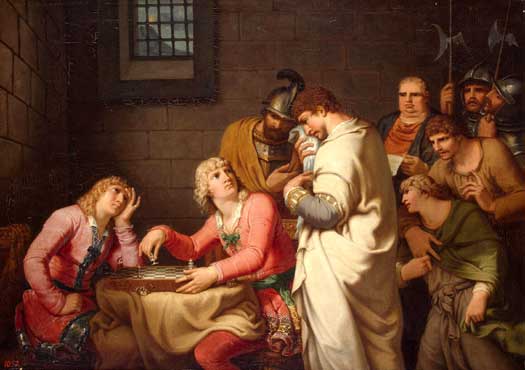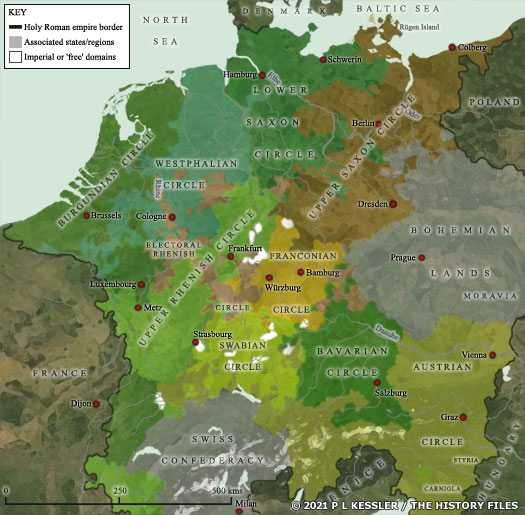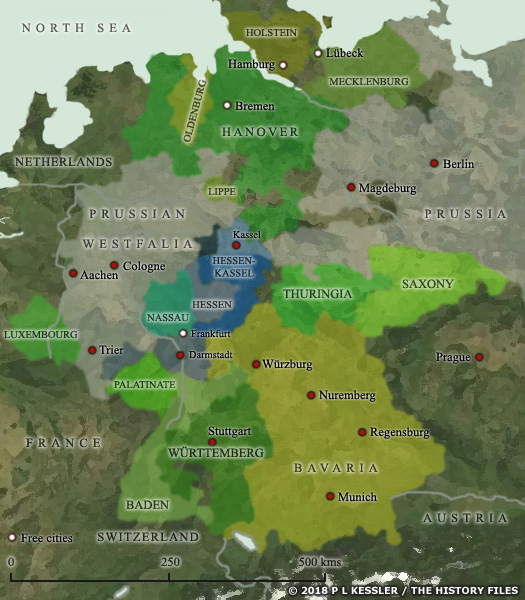|
|
|
| Margraves of Baden AD 1064 - 1536 The margraviate of Baden was formed in eastern central [Swabia](GermanySwabia.htm#Dukes of Swabia) during the general political collapse in Germany which dominated the eleventh century and became far more serious during the twelfth century. The rebellion by Rudolf of Rheinfelden became known as the Great Saxon Revolt, with him being succeeded in his opposition against Emperor Henry IV by Berthold I of Rheinfelden (rival duke of Swabia), Hermann of Luxemburg, and Conrad of Franconia. |
|
|
| 1064 - 1073 |
Herman I |
Son of Berthold I of Zähringen. d.1074. |
| 1073 - 1130 |
Herman II |
Son. Created Margrave in 1112. |
| 1130 - 1160 |
Herman III |
|
| 1151 |
Despite being a firm supporter of Holy Roman Emperor Conrad III, Duke Henry V of [Carinthia](EasternCarinthia.htm#Duchy Spontheims) loses the margraviate of Verona to his own uncle, Herman III of Baden. Perhaps this is fortunate as, in 1164, the most important of the Veronese cities band together into the Veronese League to counteract the Italian policies of the emperor's nephew, Duke Frederick Barbarossa of [Swabia](GermanySwabia.htm#Dukes of Swabia). |
|
| 1160 - 1190 |
Herman IV |
|
| 1190 - 1243 |
Herman V |
|
| 1243 - 1250 |
Herman VI |
Became Herman, Duke of [Austria](GermanyAustria.htm#Zahringen Margraves) (1248-1250). |
| 1250 - 1268 |
Frederick I |
Executed. |
| 1268 |
Conradin of[Swabia](GermanySwabia.htm#Dukes of Swabia) assembles a multinational army in [Italy](ItalyKingdom.htm#Lords of Milan), determined to secure his own claim to Sicily in opposition to Charles I of Anjou. He is ably assisted by Frederick I of Baden, but the pair are defeated at Tagliacozzo, and both are soon arrested.  This oil on canvas depicts Conradin awaiting sentence along with his ally, Frederick of Baden, as depicted by Johann Heinrich Tischbein, 1785 This oil on canvas depicts Conradin awaiting sentence along with his ally, Frederick of Baden, as depicted by Johann Heinrich Tischbein, 1785 |
|
| 1243 - 1288 |
Rudolf I |
|
| 1288 - 1295 |
Rudolf II |
|
| 1288 - 1297 |
Hesso |
|
| 1297 - 1335 |
Rudolf Hesso |
|
| 1313 |
With the death of John Parricide, any claim to the former[Swabian](GermanySwabia.htm#Dukes of Swabia) duchy dies with him. Large areas of its territory have already gone to the established county of[Württemberg](GermanyWurttemberg.htm#County of Wurttemberg) and the margraviate of Baden. Territory formerly belonging to the Alemanni people also later forms parts of[Austria](GermanyAustria.htm#Habsburg Margraves) (Vorarlberg),France (Alsace) and Switzerland, as well as the Bavarian Swabia region of[ Bavaria](GermanyBavarians.htm#Duchy of Bavaria %28Wittelsbachs%29). |
|
| 1288 - 1332 |
Rudolf III |
|
| 1288 - 1291 |
Herman VII |
|
| 1291 - 1333 |
Frederick II |
|
| 1333 - 1353 |
Herman VIII |
|
| 1291 - 1348 |
Rudolf IV |
|
| 1348 - 1361 |
Rudolf V |
|
| 1348 - 1353 |
Frederick III |
|
| 1353 - 1372 |
Rudolf VI |
|
| 1372 - 1391 |
Rudolf VII |
|
| 1372 - 1431 |
Bernard I |
|
| 1431 - 1453 |
James I |
|
| 1437 |
The titular seat of the county of Spanheim, which is located in Rhenish Franconia, now falls vacant following the death of the last male member of the family. With that, the title passes through the female line to become part of the duchy of Baden. (A senior branch of the family had also supplied several dukes to[Carinthia](EasternCarinthia.htm#Duchy Spontheims) until 1279.) |
|
| 1453 - 1454 |
George |
|
| 1453 - 1458 |
Bernard II |
|
| 1453 - 1475 |
Charles I |
|
| 1475 - 1515 |
Christopher I |
Died 1527. |
| 1515 - 1533 |
Philip I |
|
| 1515 - 1535 |
Bernard III |
Became margrave of Baden-Baden. |
| 1515 - 1535 |
Ernest |
Became margrave of Baden-Durlach. |
| 1536 |
The margraviate is divided, forming Baden-Durlach and Baden-Baden. |
|
|
|
|
| Margraves of Baden-Baden AD 1535 - 1771 |
|
|
| 1535 - 1536 |
Bernard III |
Former margrave of Baden. |
| 1536 - 1556 |
Christopher II |
Died 1575. |
| 1536 - 1569 |
Philibert |
|
| 1569 - 1588 |
Philip II |
|
| 1588 - 1594 |
Edward Fortunatus |
Died 1600. |
| 1594 - 1622 |
Interregnum. The margraviate is probably ruled by Baden-Durlach.  Introduced in 1560, the system of imperial states replaced the now-outdated feudal system, with an imperial circle ('reichskreis') being a regional grouping of the imperial states (click or tap on map to view full sized) Introduced in 1560, the system of imperial states replaced the now-outdated feudal system, with an imperial circle ('reichskreis') being a regional grouping of the imperial states (click or tap on map to view full sized) |
|
| 1622 - 1677 |
William |
|
| 1677 - 1707 |
Louis William |
|
| 1686 |
Louis William's forces form part of the Imperial Army which defeats the Ottomans in Hungary. |
|
| 1707 - 1761 |
Louis George |
|
| 1761 - 1771 |
Augustus George |
|
| 1771 |
Augustus has no heir, so the title of Baden-Baden falls to the margraves of Baden-Durlach, and the divided territory is reunited. |
|
|
|
|
| Margraves of Baden-Durlach AD 1535 - 1806 |
|
|
| 1535 - 1552 |
Ernest |
Former margrave of Baden. |
| 1552 - 1553 |
Bernard IV |
|
| 1552 - 1577 |
Charles II |
|
| 1577 - 1590 |
Ernest-Frederick |
|
| 1577 - 1590 |
James III |
|
| 1590 - 1591 |
Ernest James |
|
| 1577 - 1622 |
George Frederick |
Died 1638. |
| 1622 - 1659 |
Frederick V |
|
| 1659 - 1677 |
Frederick VI |
|
| 1677 - 1709 |
Frederick VII |
|
| 1709 - 1738 |
Charles III William |
|
| 1738 - 1806 |
Karl Friedrich |
Elector (1803). |
| 1751 |
Frederick king of Sweden dies without having produced an heir. In his landgraviate of Hessen-Kassel he is succeeded by his brother, William VIII. Sweden elects Adolphus Frederick, son of Christian August of Holstein-Gottorp and Margravine Albertina Frederica of Baden-Durlach (daughter of Frederick VII). Despite the instigation of the Russo-Swedish War by parliament and the country's humiliating defeat, the Swedish monarchy still has little real power, with the result that Adolphus Frederick is a weak ruler. |
|
| 1771 |
Augustus of Baden-Baden has no heir, so the title falls to the margraves of Baden-Durlach. |
|
| 1806 |
Baden-Durlach is raised to a [Grand Duchy](#Grand Duchy) by Napoleon I of [France](FranceFranks.htm#First Empire). |
|
|
|
|
| Grand Dukes of Baden AD 1806 - 1918 (Additional information from The First World War, John Keegan (Vintage Books, 2000).) |
|
|
| 1806 - 1811 |
Karl Friedrich |
Formerly margrave. |
| 1811 - 1819 |
Karl Ludwig |
|
| 1818 - 1830 |
Ludwig I |
|
| 1830 - 1852 |
Leopold |
|
| 1852 - 1856 |
Ludwig II |
|
| 1856 - 1907 |
Friedrich I |
|
| 1871 |
Baden becomes a part of the Prussian German empire.  Following the defeat of Napoleon Bonaparte 1814, the Congress of Vienna took on board much of his vital restructuring of the German principalities, with the result that a map of the new Confederation of German States in 1815-1817 looked very different to maps of the previous century (click or tap on map to view full sized) Following the defeat of Napoleon Bonaparte 1814, the Congress of Vienna took on board much of his vital restructuring of the German principalities, with the result that a map of the new Confederation of German States in 1815-1817 looked very different to maps of the previous century (click or tap on map to view full sized) |
|
| 1907 - 1918 |
Friedrich II |
Died 1928. |
| 1918 |
All German monarchies are abolished upon the defeat of the German empire in the First World War. Baden is recreated as a constituent part of the new federal Germany and its future fortunes would be tied to this new political creation. |
|
 |
|
|
 This oil on canvas depicts Conradin awaiting sentence along with his ally, Frederick of Baden, as depicted by Johann Heinrich Tischbein, 1785
This oil on canvas depicts Conradin awaiting sentence along with his ally, Frederick of Baden, as depicted by Johann Heinrich Tischbein, 1785 Introduced in 1560, the system of imperial states replaced the now-outdated feudal system, with an imperial circle ('reichskreis') being a regional grouping of the imperial states (click or tap on map to view full sized)
Introduced in 1560, the system of imperial states replaced the now-outdated feudal system, with an imperial circle ('reichskreis') being a regional grouping of the imperial states (click or tap on map to view full sized) Following the defeat of Napoleon Bonaparte 1814, the Congress of Vienna took on board much of his vital restructuring of the German principalities, with the result that a map of the new Confederation of German States in 1815-1817 looked very different to maps of the previous century (click or tap on map to view full sized)
Following the defeat of Napoleon Bonaparte 1814, the Congress of Vienna took on board much of his vital restructuring of the German principalities, with the result that a map of the new Confederation of German States in 1815-1817 looked very different to maps of the previous century (click or tap on map to view full sized)